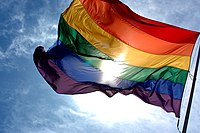rainbow flag
Jump to navigation
Jump to search
English[edit]

Various flags which have been referred to as rainbow flags.
Noun[edit]
rainbow flag (plural rainbow flags)
- A rainbow-striped flag, typically consisting of six horizontal bars (from top to bottom: red, orange, yellow, green, blue, and violet), used as a symbol of LGBT pride and LGBT social movements.
- The rainbow peace flag.
- The flag of South Africa.
- 1996, Nelson Mandela, “Address […] at the Parade of Champions from Atlanta Olympics”, in Speeches by Nelson Mandela[1]:
- The extraordinary Josia Thugwane kept the best for last and made the rainbow flag fly over the closing ceremony of the Games. […] Today we honour all our athletes who ensured that the rainbow flag never touched the ground in Atlanta.
- 2008, Lizzie Williams, South Africa (Spiral Guides), Heathrow, FL: American Automobile Association, →ISBN, page 10:
- In 1994 South Africa held its first fully democratic elections which were overwhelmingly won by the ANC and Mandela became the first black president. At midnight on April 26th the new rainbow flag was raised and the new national anthem, Nkosi Sikelel iAfrika (God Bless Africa), was sung across the nation.
- 2012, Jacob Zuma, “Statement by His Excellency […] on the occasion of the send off ceremony for the Olympic and Paralympics Teams”, in The Presidency (Republic of South Africa)[2]:
- We are pleased to be sending off our hard working teams to go and represent the nation abroad, and fly the rainbow flag high.
- 2014, Edmond Furter, Mindprint, Lulu.com, →ISBN, page 134:
- Mandela is a Xhosa, an eastern Bantu tribe with some admixture of Bushman genes and language. He is also the integrator of the highly diverse South African nation, with a half Portuguese wife […] thus Mandela is a 'painted', ordained figure, incidental with attributes of the type, and the South African rainbow flag.
- 2015 May 15, Michael Kirby, “Foreword”, in Mark Trowell, The Prosecution of Anwar Ibrahim[3], Singapore: Marshall Cavendish, →ISBN:
- That is how the invitation to President Mandela's inauguration fell to me. As I watched the ceremonies, and observed the rainbow flag of a newly freed nation unfold, I reflected on the growth of the international scrutiny of contested laws in every country, including my own.
- (historical, now rare) The flag of the First Republic of China, used between 1912 and 1928, consisting of red, yellow, blue, white, and black stripes.
- 1919, Arthur Richmond Marsh, The Economic World, page 548:
- Just as the rainbow in the blue skies, after a rainstorm, testifies to the existence of imperishable sunshine in the higher firmament, so this rainbow flag of China, born in the throes of the Chinese Revolution, is a standing proof of our abiding faith in democratic government […]
- 1924, Freemasons. Grand Lodge of Massachusetts, Proceedings of the Most Worshipful Grand Lodge of Ancient Free and Accepted Masons of the Commonwealth of Massachusetts, page 601:
- […] but each Chinese patriot following me will bear, as I bear before you my beloved Chinese rainbow flag, which has come to its life because of the Stars and Stripes. (Displaying the two flags.)
- 2018 April 15, Daniel MacCannell, Rainbows: Nature and Culture, Reaktion Books, →ISBN:
- Officially, however, the five 'strips' or stripes on the Chinese rainbow flag represented – in addition to all five colours of the rainbow as traditionally conceived there – the country's […]
- A wiphala.
- 2005, Eric Toussaint, Your Money Or Your Life: The Tyranny of Global Finance, Pluto Press (UK):
- This new national identity is manifested by the rainbow flag known as the Wiphala in the Aymara language and is anchored in several zones, such as El Alto, and in the indigenous communities.
- 2014 October 2, Marc Becker, Cases of Exclusion and Mobilization of Race and Ethnicities in Latin America, Cambridge Scholars Publishing, →ISBN, page 64:
- The rainbow flag, the wiphala, became the visual representation of the previously clandestine Indian nation and was carried in all public manifestations as a symbol of rebellion. The claim to nationhood became complete with the […]
- 2019 December 5, Tom Bieling, Design (&) Activism: Perspectives on Design as Activism and Activism as Design, Mimesis, →ISBN:
- In Bolivia, the Katarista movements of the 1970s revived the Wiphala flag symbolizing Qullasuyu, their quadrant of the Inca empire, as part of their rural, indigenous and anti-colonial politics. The rainbow flag of forty-nine squares […]
Synonyms[edit]
Translations[edit]
rainbow-striped flag used as a symbol of LGBT pride and social movements
|
See also[edit]
Further reading[edit]
 Rainbow flag (LGBT movement) on Wikipedia.Wikipedia
Rainbow flag (LGBT movement) on Wikipedia.Wikipedia


